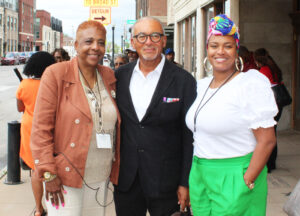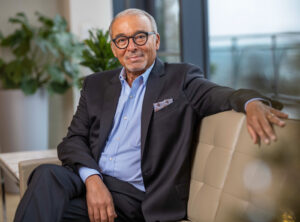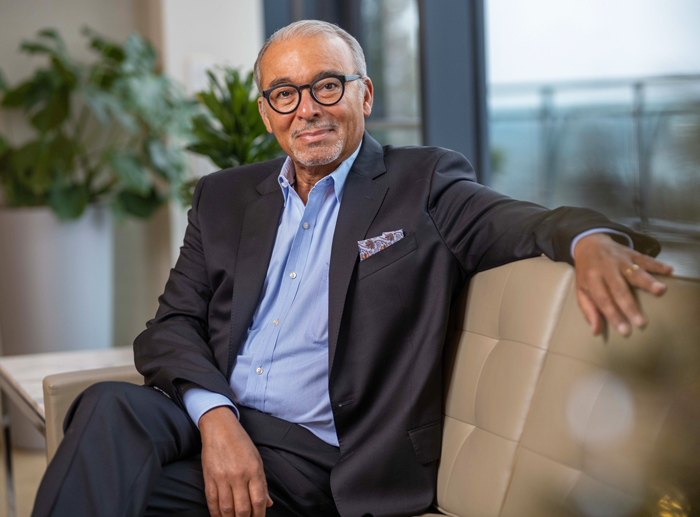
By Asia Nail
The Truth Reporter
On October 18, 2024, an electrifying conversation unfolded between Robert Smith, founder of the African American Legacy Project, and former Columbus Mayor Michael Coleman, a proud Toledo native. This was more than just a discussion; it was a passionate call to action, igniting a shared vision for the future. They emphasized the vital importance of nurturing our communities—especially our local artists, the Black community and our youth—to pave the way for a brighter, more hopeful tomorrow for everyone. Their dialogue resonated with urgency and inspiration, reminding us all of the power we hold to effect real change.
A Legacy of Change
Michael Coleman made history as Columbus’s first African American mayor and served for an impressive 16 years. His roots trace back to Toledo, where he grew up with a vision of what could be. He often reflects on his childhood dreams of becoming an architect. “I wanted to shape spaces that would bring people together,” he shared during the interview. This passion for building, both literally and metaphorically, fueled his drive to make significant changes in Columbus.
When Coleman took office, he inherited neighborhoods that were struggling. The King-Lincoln Bronzeville district, a historically significant area for the African American community, was once the vibrant heart of commerce, culture, and connection in Columbus during the 1930s, ’40s, and ’50s. However, the construction of Highway 71 cut off access, leading to isolation and a mass exodus of black residents during desegregation.
Over the following decades, the population plummeted from 64,000 to just 16,000, leaving behind a landscape of abandoned buildings and overgrown lots. In this context, Coleman recognized the urgent need for revitalization: “I can’t be the first Black Mayor and not deal with this,” he said to himself.
“Initially I revitalized an area on Morris Rd. in this district by acquiring the former Northland Mall, which I ultimately demolished despite significant controversy,” Coleman shares with Smith.
”I invested millions into the streetscape, developing the area and addressing the long-standing issue of disinvestment, thereby transforming the community for the better.”

The Power of Physical Space
Imagine a garden that has been neglected, its flowers wilted and its pathways overgrown. Coleman envisioned this garden blooming once again. He believed that transforming physical spaces could revive community spirit and reconnect people to their roots. A pivotal moment in this journey was the revitalization of Lincoln Theater, a historic venue that had long served as a gathering spot for the Black community.
“The Lincoln Theater was where our community went when they couldn’t go downtown,” Coleman explained. Legends like Duke Ellington and Sammy Davis Jr. graced its stage, making it a cornerstone of cultural life. But by the time Coleman took action, the theater was on the brink of being demolished. “I had a gut feeling that even with all the damage, I could change this,” he recalled. Despite the pushback and controversy, Coleman purchased the theater with city funds and committed to its restoration.
This decision sparked not just renewed interest in the theater, but a broader revitalization of the surrounding area. After the Lincoln Theater was transformed into a thriving cultural hub, it attracted thousands of visitors and new residents to the downtown area. However, Coleman’s vision extended far beyond the theater; laying the groundwork for a complete resurgence of economic opportunities and community pride in the region.
Building Together
As Coleman spoke about his vision, he emphasized the importance of community involvement. “You just have to do it and try to bring folks along in the process,” he said. It wasn’t enough to have a plan; he had to sell that vision to the people living in the neighborhoods, to those outside of them, and to the business community. “I was the biggest salesperson for my vision,” he quipped, illustrating the necessity of belief and enthusiasm in leadership.
One of the key elements to his success was the idea of collaboration. Coleman invited input from diverse people within the community, integrating their ideas into the revitalization plans. “Have everyone paint on a blank canvas with different pots of paint,” he suggested. By involving the community in the planning process, he ensured that the revitalization efforts reflected their desires and needs. In the end, the result was a masterpiece—an enriched community where everyone had a vested interest in success.
The Importance of Youth and Arts
Coleman’s commitment to revitalization extended beyond buildings and businesses; he believed in empowering young people and supporting the arts. “What’s going to make young people want to come to the City of Toledo?” he asked. His answer was simple: ask them. When Coleman engaged local youth, he discovered what they truly wanted in their city—opportunities for creativity, connection, and growth.
In Columbus, Coleman collaborated with The Ohio State University to bring students into the city’s culture. They hosted events at local arenas, complete with music, fine dining, art, and activities designed to showcase what Columbus had to offer. “The kids loved it!” he beamed, noting that this engagement fostered a sense of belonging among students. Over time, this effort paid off, as many students chose to stay in the city after graduation, starting businesses and contributing to their communities.
Art, too, became a vital component of Coleman’s vision. He understood that subsidizing artists in concentrated areas of the city could lead to vibrant cultural districts, attracting more people and fostering economic growth. “As for Toledo, watch your art district explode with new opportunities if you implement these strategies,” he said, envisioning a future where creativity fuels revitalization and transforms areas into bustling hubs of innovation and expression. By investing in the arts, he believes, most cities can harness the power of culture to drive progress and bring people together.
Economic Empowerment
Central to Coleman’s vision was economic empowerment. He recognized the significant wealth gap faced by Black and Hispanic communities, often stemming from a lack of access to banking services. To address this, he and other leaders founded the Adelphi Bank, the first Black-owned bank in Ohio. “It’s important as a community that we embrace black-owned banks and do everything we can to help them succeed,” he stated, underscoring the need for financial institutions that truly represent and serve every community.
The creation of Adelphi Bank was not just about providing loans; it was about restoring financial dignity and fostering entrepreneurship within the Black community. Coleman’s vision for the bank was rooted in the belief that when individuals have access to resources, they can create their own opportunities, invest in their communities, and build generational wealth.
Learning from History
Coleman’s reflections were deeply intertwined with the history of the Black community in Toledo and beyond. He lamented the loss of historical businesses and cultural landmarks in our hometown, recalling how Dorr Street once buzzed with life. “I didn’t see a single business that I remember, not one,” he said, a sense of sadness in his voice. “Toledo destroyed its Black heritage. It’s time to re-build.”
He emphasized the importance of remembering the past as a guide for the future. “You don’t know where you’re going until you first understand where you come from,” he advised. This understanding is crucial for the Black community in Toledo as they navigate their path forward. “If Black people in Toledo want to restore their heritage, they must speak up and work together,” he urged, reinforcing the need for unity and collective action.
A Brighter Future
As the interview wrapped up, Coleman’s hopeful vision for Toledo shone brightly. He believes that by nurturing artists, supporting the Black community, and engaging youth, the city can become a thriving landscape of culture, commerce, and connection once again. “In ten years, we will see an urban transformation,” he predicted, his eyes sparkling with optimism.
Toledo shares many similarities with Columbus, including a strong educational presence with institutions like the University of Toledo. Coleman sees immense potential in identifying and engaging young people, ensuring they feel valued and invested in their city. “When young people stay in the city, they’re going to start businesses, start families, and create jobs,” he explained, painting a picture of a vibrant future.
The Canvas of Community
The conversation with past Mayor Michael Coleman was not just about one man’s legacy; it was a broader call to action for cities everywhere. By fostering collaboration, supporting the arts, and empowering communities, we can create environments where every voice matters and every dream has the potential to flourish.
In a world that can sometimes feel overwhelming, Coleman’s story reminds us that change is possible. Just as an artist approaches a blank canvas, we all have the power to contribute to the masterpiece that is our community. With hope, determination, and a commitment to unity, we can nurture our cities and create spaces where everyone can thrive.
Watch the AALP Interview w/Mayor Michael Coleman here

